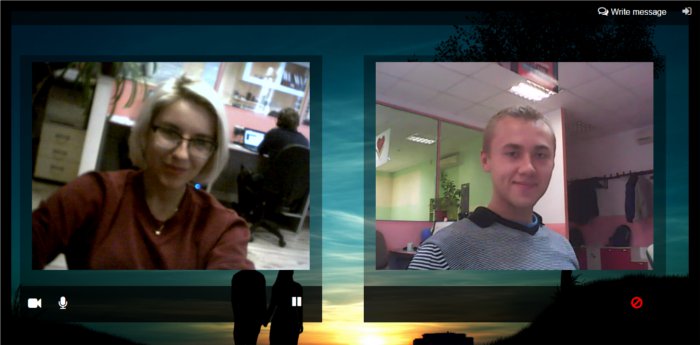

Once perceived as invasive, cameras in personal space became mainstream. “A host of video-based platforms have all emerged along parallel tracks over the past 15 years, and they’ve had a way of reinforcing one another’s success by normalizing online video interactions,” says Parks.

The proliferation of smartphones and built-in cameras served as an accelerant. “I grew up…dreaming about video calling, and now it’s real,” Jobs told an enthusiastic audience, recalling futuristic depictions of video calls on The Jetsons during his childhood. Then in 2010, Apple CEO Steve Jobs unveiled the iPhone 4’s FaceTime.
#ONE ON ONE VIDEOCHAT PC#
Commercial webcams followed soon after, paving the way for services such as Skype to connect PC users in the early 2000s. Surprisingly, it gained millions of fans. In 1993, a University of Cambridge scientist was tinkering with a camera used to monitor coffee pot levels, and connected it to the fledgling world wide web. Yet despite years of defeats, “the idea, the lure of telephony endured,” says Hochheiser.Īn accidental breakthrough hastened video calling’s trajectory-and shifted it to an entirely different medium. In 1995, it too was discontinued, seemingly vexed again by a reluctant market. In 1992, AT&T tried again with the VideoPhone 2500, which was compatible with existing phone lines. In the 1980s, video phones-launched by domestic and international competitors getting in on the game-inched forward. “To have an innovation that scales, that makes an impact on society or business, you really have to check a lot of boxes.”

“For an innovator, being early is pretty close to being wrong,” says Gertner. One columnist raised the specter of a call “every time we allowed ourselves to relax in our tired old bathrobe.” Such fears undoubtedly resonate with many quarantined teleworkers today.

The effort sputtered out in 1973.īut another reason came as a surprise, and it had nothing to do with technology: “It turns out people don’t want to be routinely seen on the telephone,” says Hochheiser. Hoping to build on this momentum, the service was introduced into offices in select markets in 1970, but AT&T was unable to garner a sufficient number of users to make the idea work. Lady Bird Johnson did the inaugural honors, “with the smiling ghost of Alexander Graham Bell looking over her shoulder,” as the Palm Beach Post noted with flourish. Soon after, the company opened Picturephone rooms in New York, Washington and Chicago. Get your history fix in one place: sign up for the weekly TIME History newsletter Streams of visitors could try the devices, while market researchers gauged interest. That moment-or so researchers hoped-arrived in 1964, when AT&T introduced the Picturephone at the World’s Fair in New York City, complete with a promotional cross-country call to Disneyland. “The idea of visual communications was still alive at Bell Labs, but waiting for the right moment technologically, socially, culturally,” says Jon Gertner, author of The Idea Factory: Bell Labs and the Great Age of American Innovation. At the time, even if there had been demand for the product, networks lacked the carrying capacity needed to transmit visual calls with desirable resolution. (The company had monopolistic control of the nation’s incipient phone services, giving it primacy in research and development.) But the research could only go so far. After that public debut in 1927, work continued at AT&T’s Bell Labs.


 0 kommentar(er)
0 kommentar(er)
